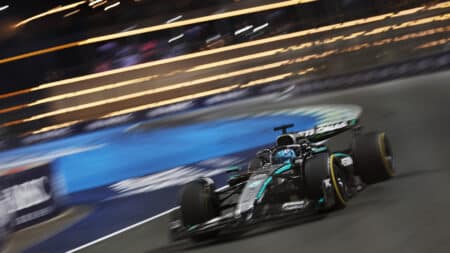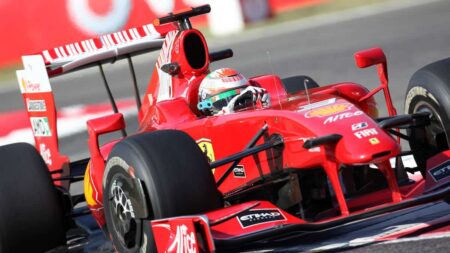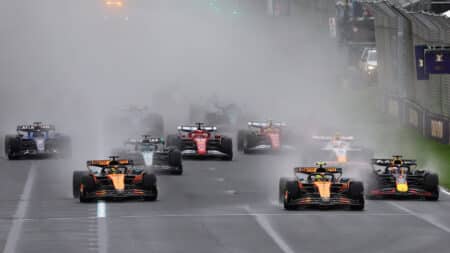April 2, 2008

Your highness, ladies and gentlemen. Traditionally, it’s stories, not speeches that start with the phrase “Once upon a time”. No, speeches don’t tend to begin that way, but I’m going to kick off my speech by telling you a story.
So… Once upon a time, there was a boy called… well… I’ll tell you who he was in a minute. First, I’ll tell you a little bit about him.
The year is 1966, and the place is Surrey, in the southeast of England. He’s 18, he loves motor sport, and he’s working at Coopers, in Byfleet, assembling Formula 2 and Formula 3 cars. He’s also on a day release course, studying motor vehicle technology.
He’s rarely been outside Surrey, and he’s never been abroad. He’s been overseas once, if you can call travelling on a family holiday to the Isle of Wight, by steam ferry, overseas. Then, out of the blue, he’s made an offer: to fly to Mexico City to work on the third Cooper-Maserati, to be driven by local hero Moises Solano, at the Mexican Grand Prix.
Well… what do you think he says? He says yes. He says yes in about five seconds flat! Forty-two years later, he’s your speaker this morning. Because I was that 18-year-old boy.

Formula 1 was very different back then. There were only nine races in the 1966 grand prix season. Sponsorship was virtually non-existent – whereas now Formula 1 attracts sponsorship from some of the world’s biggest and most well-regarded blue-chip multinational corporations, and only two of the races were outside Western Europe – the United States Grand Prix and the Mexican Grand Prix.
There are 18 grand prix this year – exactly twice as many as there were in 1966. Only eight of them are in Western Europe. The other 10 are scattered across all five continents. Two in Eastern Europe. One in North America. One in South America. One in Australia. No fewer than four in Asia. And one here in the Middle East.
Where is Formula 1 slated to be going next? Well, Russia, India, South Korea, Abu Dhabi, Qatar. And perhaps a return to the United States. I welcome this expansion, and heartily commend Bernie Ecclestone for spearheading it. But I have two provisos: Firstly, that the season never expands to more than 20 grand prix, which I regard as a natural logistical limit and, secondly, that we preserve a closed season over the winter. The closed season is essential not only for logistical reasons but also in order to stir up a sense of anticipation in the hearts and minds of Formula 1 fans.
The best-selling editions of Formula 1 magazines are always the season preview editions, for example, not the editions that are published during the season. And that’s because a sense of anticipation has been stirred up in the hearts and minds of Formula 1 fans over the preceding winter. So, as I say, we must preserve that.
Going back to 1966, which it so happens was McLaren’s first year in Formula 1 as well as my first year in Formula 1, teams comprised a dozen people, sometimes fewer. Budgets were tiny. Facilities were rudimentary. Mechanics and engineers worked on their cars on patches of grass or concrete, and the paddock was exactly that: a paddock.
Compare that to the state-of-the-art pit and paddock complexes we use nowadays, exemplified by the stunning facilities here in Bahrain.
Now, though, in order to be successful, a Formula 1 team will need an annual budget measured in hundreds of millions of US dollars. There is, as we all know, a positive move to reduce costs in Formula 1.
Budget-caps are the latest idea. I support any idea that reduces costs in Formula 1. Yes, Formula 1 is expensive to do well – but that doesn’t mean that well-run teams aren’t also well controlled financially, with budgets strictly adhered to. I like to think of myself as a businessman, an entrepreneur. But I’m also a racer, through and through.

For me, the two things go hand in hand. And for Formula 1 to continue to thrive in the way it has thrived all these years, we’ll need rules that foster freedom of entrepreneurship, but we’ll also need rules that encourage close and competitive racing. And if we can frame those rules in such a way as to keep costs in check, or even reduce costs, so much the better.
What would rules like that look like? What one quality might they contain? I’ll tell you the answer to that, in one word. Stability. Because every time the rules are changed, the result is almost always a cost increase. And, because the smaller teams are perhaps less able to meet those cost increases, they may not respond as effectively to a rule change as their more affluent competitors.
And yet we must change the rules, because the world is changing. But, because we also need regulatory stability, our rule changes must be evolutionary, not revolutionary.
We must respond to environmental concerns – and, as I’ve said, perhaps that response may require rule changes – and of course I applaud the carbon replacement programme that the FIA has been running in Mexico for a dozen years or more. Equally, I support the FIA’s other environmental initiatives.
KERS, or Kinetic Energy Recovery Systems, if developed prudently, will be a sensible and innovative system whereby the waste heat produced by braking can be harnessed and re-used in a way that may be adapted and then adopted by the production cars of the future. It’s an exciting area.
Perhaps paradoxically, Formula 1 is uniquely well-placed to showcase and spread awareness of environmental messages.
It’s uniquely well-placed because of three things: (1) Formula 1 budgets are sufficient to enable bright engineering minds to explore exciting new technologies – including green technologies. (2) The engineering resource is already there – particularly on the engine side, which is where most environmental gains will be made. (3) And, last but very far from least, Formula 1 represents a fantastically effective global communication platform via which to spread awareness of such exciting new technologies, beamed via live TV to 140 countries worldwide.
Honda’s myearthdream.com campaign is interesting. But Honda isn’t the only team which is thinking green. Many teams are beginning to think in an ever-greener way. The McLaren Technology Centre is very efficient, very green if you like. Our lake isn’t merely ornamental. It harnesses the waste heat created by our manufacturing and wind tunnel testing process, so that we can re-use that energy to heat and cool our building.
We have a department at the McLaren Technology Centre called Managed Services, whose objective is to find ways of running our building in an ever-leaner, ever-greener way. Its target is clear: to reduce fixed operational costs by a percentage equal to or greater than the prevailing rate of inflation, every year.
No doubt about it, the environment is an area that Formula 1 must continue to focus on, and the FIA has shown great enlightenment in showing the way so early.
Safety, too, is vitally important – and requires regulatory support, maybe even rule changes. Some of the rule changes that the FIA and FIA Institute have ushered in over the past few years have undoubtedly saved drivers’ lives. They’ve done some truly excellent work – especially in recent years.

It’s impressive, too, that, here in Bahrain, tomorrow, under the patronage of the Kingdom of Bahrain Ministry of Health, there will be an FIA Institute Safety Summit, which will feature the launch of the FIA Institute Medical Faculty and the distribution of the FIA Institute Core Curriculum.
So we need new rules, but we need to introduce those new rules very carefully. We need to make Formula 1 greener and safer, and I’m delighted that the FIA and FIA Institute are fully engaged in that process.
We need to make Formula 1 less expensive, too, and we need to do that very carefully as well. Because we should never forget that entrepreneurship was how we got to where Formula 1 is today.
Entrepreneurship. A very important Formula 1 word. Because, in order for Formula 1 to continue to thrive in the way it has thrived over the past half-century, we must foster an environment wherein entrepreneurship can continue to flourish freely.
That freedom of entrepreneurship – exemplified by the involvement in Formula 1 of the Kingdom of Bahrain, via its excellent grand prix circuit as well as via its shareholding in McLaren – is how Formula 1 has become what it has become. Entrepreneurship remains essential to the future development of Formula 1.
And, despite Formula 1’s glorious heritage, its past, the future of Formula 1 is more exciting still. And that’s because its future could, and should, be even more glorious than its past.
And if all the current Formula 1 teams are to be involved fruitfully in terms of the profitable enjoyment of every Formula 1 stakeholder and if the six major car manufacturers currently involved in Formula 1 are to continue to maximise the return on their investment – Mercedes-Benz or Daimler, of course, but also Ferrari or Fiat, Renault, BMW, Honda and Toyota, then the rules by which we go motor racing must be conducive to that entrepreneurship.
Yes, the rules must respond to a changing world, must reflect environmental issues. Yes, the rules must make Formula 1 as safe as it possibly can be, for drivers, for trackside marshals, for trackside photographers, for trackside cameramen, and of course for trackside spectators. Yes, the rules must make the way we go racing greener, more environmentally friendly. We – McLaren – I – support all that. Emphatically.
President Abraham Lincoln once said, “If I had eight hours to cut down a tree, I’d spend the first six hours sharpening my axe.” There’s a huge amount of relevant truth in that. Extensive preparation doesn’t only produce a better result – it produces that result more quickly, too. And our job, as far as the rules are concerned, is a lot more complex than chopping down a tree. Because, at the risk of repeating a cliché, Formula 1 must remain the pinnacle of motor sport – from an engineering point of view as well as from every other point of view.
The pinnacle of motor sport. It may be a cliché, but it’s an important cliché – and a valid one, too.
The day when Formula 1 stakeholders – and I include Formula 1 fans in that categorisation – begin to doubt Formula 1’s status as the pinnacle of motor sport, we are lost. That day must never come. We must never go back to basics. We must never go back to 1966.
I want to say something about what Formula 1 people call “the show”. The spectacle. Because of course the show is all-important, too – and the rules must encourage entertaining racing. But I think they do. I think, as far as encouraging entertaining racing is concerned, the FIA’s Sporting and Technical Regulations already do a pretty good job.
We who work in Formula 1 are very good at beating ourselves up about how our sport needs to be improved from a spectacle point of view. We ask questions in fan surveys like “Would you like to see more overtaking in Formula 1?”, and then we nod sagely and scratch our heads when the answer comes back “Yes”.
But think about it: what would you expect the answer to come back as?! What Formula 1 fan would answer a question like that with the answer “No”?! What Formula 1 fan would say to themselves, “Would I like to see more overtaking in Formula 1… no, I wouldn’t!”? No-one would say that.
People have short memories. People wax lyrical about the 1960s, about Wolfgang von Trips and Jim Clark and so on. Undoubtedly, they were great drivers – just as today’s drivers are great drivers – but was the racing really better then than it is today?
I was there, and I can tell you that it was not. And, while we’re on the subject, it was a lot more dangerous, too. My first grand prix, the 1966 Mexican Grand Prix, was won by the team I was working for, Cooper-Maserati. Our winning driver, John Surtees, won from pole position.
And was it great racing? Was it greater racing than racing today? Well, at the end of the 65-lap race, which took two hours and six minutes to complete, there was only one other car on the same lap as John Surtees. Was the 1966 Mexican Grand Prix an exception? No, it wasn’t. Most of the grand prix that constituted the 1966 Formula 1 season were like that.
I’ve talked a bit about the past, and I hope I’ve shown that the present is a more glorious place. I firmly believe it is. I’ve talked about rules, and the need to foster entrepreneurial freedom and encourage competitive racing via regulatory stability. But I’ve also talked about the need for regulatory evolution, not revolution, in the areas of the environment and safety.
But let me finish by talking about the future, about my 2020 vision, if you like. I passionately believe that the most glorious chapters of Formula 1 history are yet to come. As long as we maintain systems that encourage competitive racing via regulatory stability, and foster entrepreneurial freedom, yet reflect the world’s changing environmental priorities, then the future of Formula 1 can be every bit as glorious as we want it to be.
Vodafone McLaren Mercedes aims to be in the vanguard of the process of writing that glorious chapter, but Formula 1 is fortunate enough to be populated by a number of famous names. Our principal competitors are all famous names, and many of them have been uninterruptedly involved in Formula 1 for a very long time, as we have. Only four of the teams that have ever won drivers’ or constructors’ championships are still in existence today.
But I’ll leave you with two rather less data-inspired comparisons. I hope you like them, and I hope they impress you. I hope they make you think: “Yes, that’s what Formula 1 teams should be all about. That’s what I understand by the phrase ‘pinnacle of motor sport’.”
My first comparison is between a state-of-the-art Formula 1 car and the Lockheed SR-71 ‘Blackbird’. Beauty is in the eye of the beholder, so they say. Well, I think they’re both beautiful – but their beauty resides in the beholder’s realisation that their form follows their function. No ornamentation for ornamentation’s sake. Not one stylist was involved in either design. Just form following function. And the result is beauty.
But, going further than that, the Lockheed SR-71 ‘Blackbird’ has always fascinated me because, like a state-of-the-art Formula 1 car, it’s an expression of what at first sight seems an unusual and perhaps incongruous combination: namely, big-picture thinking, rapid development and attention to detail.
Think about it. A Formula 1 car exists to win grand prix. To cover 305 kilometres, or 190 miles, in as short a time as possible. It’s the expression of the harnessing of the unstinting efforts of upwards of 1000 utterly focused experts – efforts that are then distilled into 18 motor races driven by two equally focused, equally expert, individuals. It’s a macroscopic effort with a microscopic result, rapidly developed. It’s big-picture thinking and attention to detail.
The scope of its ambition is limitless – to be the best. I find that objective – to be the best – thrillingly open-ended. Literally limitless. And it encourages – no, it demands – an utterly uncompromising technological mindset.
Just like the utterly uncompromising technological mindset that drove the team that designed and built the Lockheed SR-71 ‘Blackbird’, which was conceived to fly so fast, and so high, that nothing could intercept it.
Think about that for a moment. Imagine how daunting, how apparently unattainable, that design brief must have at first appeared. What a vision! What flair!
And to make it capable of flying at 80,000 feet, or 24,000 metres, and at Mach 3, or 2280mph, or 3650km/h, and to make its reconnaissance equipment so powerful that it could take an accurate picture of a car’s licence plate from that altitude.
It was, and could only ever have been, created by individuals whose technological ambition was so towering that it verged on extremism. That it verged on the seemingly impossible. That it made the apparently impossible… possible.
My second comparison is between a state-of-the-art Formula 1 car and a bumblebee. Yes, that’s right, a common-or-garden bumblebee. Why? Because, according to the laws of physics, a bumblebee shouldn’t be able to fly. And yet it can fly.
Again, like the Lockheed SR-71 ‘Blackbird’, it has made the apparently impossible… possible. And why am I telling you all this? What’s the relevance? Because that’s what Formula 1 is all about. Formula 1 is all about making the apparently impossible… possible.
That’s what Formula 1 should always be all about. That’s why so many millions of people watch Formula 1 on TV. That’s why companies invest so many millions of sponsorship dollars in Formula 1. That’s why so many millions of people love Formula 1.
Ingenuity. Entrepreneurialism. Relevance to a changing world. And the relentless pursuit of perfection.
And that’s my 2020 vision for Formula 1. That combination. And it’s by continuing to make the apparently impossible possible, that Formula 1 can, and must, retain its special, iconic, thrilling status.
The pinnacle of motor sport. It’s all we have. It’s what we are.
Thank you.








